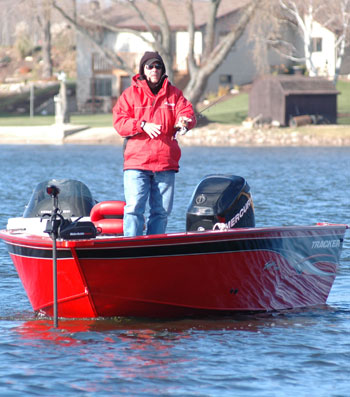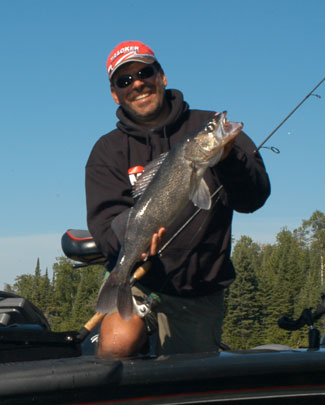Where do you typically begin your walleye fishing season every year? If you’re like most of us, it’s on a river. The walleyes are there to spawn and the bite is predictable. Now that we are approaching the later stages of the season, that river may again be a good bet to find some great walleye fishing. Look at it this way … the walleyes don’t just show up in those river spots in the spring. They actually begin that migration in the fall. That means your best favorite “spring” walleye river is loading up right now with hungry, aggressive fish. On top of that, those packs of boats that you competed against for fishing holes last spring are gone (most of those guys are either hunting or at home watching football). So face it; if you’re not heading back to your favorite walleye river in the fall, you’re likely missing out on some fabulous fishing!
 Pinpointing walleye location in rivers during this time of year is tied very closely to water levels. High water levels and heavy current will put fish in much different locales than low, slow running water. Luckily, in most cases, even water levels can be predictable. While there are exceptions, typically rivers will be at their lowest levels as autumn begins. Then once the calendar edges closer to winter, variables such as lake draw-downs, increased power generation for hydro-electric facilities, rain and in some cases even snowfall will raise river levels and increase current flow.
Pinpointing walleye location in rivers during this time of year is tied very closely to water levels. High water levels and heavy current will put fish in much different locales than low, slow running water. Luckily, in most cases, even water levels can be predictable. While there are exceptions, typically rivers will be at their lowest levels as autumn begins. Then once the calendar edges closer to winter, variables such as lake draw-downs, increased power generation for hydro-electric facilities, rain and in some cases even snowfall will raise river levels and increase current flow.
Let’s cover the various places to find walleyes during the low water periods along with the basic presentations that have served us well over the years.
The fish are moving into the river now … not setting up in any one place … they’re on the prowl … feeding and then moving on. You need to intercept them in those spots where their migration route offers good feeding opportunities. Key in on the channel edges; places where the channel changes. These are the spots that walleyes will use as “rest stops” and feeding stations. Incoming creeks will form a delta, or a hump where it contacts the main channel. Wing dams are always going to attract fish and outside bends in the channel create wash-outs and eddies are good areas to hold walleyes.
Presentations that are used for low water and slow current need to match the particular area and situation where you are targeting walleyes. Smaller, more isolated spots … like the hole on an outside bend, or the wash out area of a wing dam, are prime spots for vertical jigging. Normally you’re dealing with fairly light current and moderate depths … ten to twenty feet being the average … so keep your jig selection in the 1/8 to 3/8 ounce range. Jigging action can be a bit more aggressive than you used in the spring, but it often makes a big difference in the number of bites you’ll get if you get in the habit of leaving your jig rest on the bottom a little longer than you normally do. We can’t say precisely why that is, but experience has taught us that walleyes in these situations like to suck the bait off the bottom. This is where using the right style jig can pay huge dividends too. Opting for a semi-stand-up style jig, like the Bass Pro Shops XPS Walleye Angler Jig, will position the bait angling slightly off bottom, making it an easy target to get slurped up.
Walleyes this time of year are looking to fill their bellies, so it also helps if you offer them something that would be considered more of a “Hungry Man Meal” than an appetizer. Bulking up your jig offering, either by using larger-than-average sized minnows (four to five inchers are good), or by adding a plastic body such as a four inch Berkley GULP! Minnow or a four inch Berkley PowerBait Ripple Shad will add the size and attraction to get these fall walleyes’ attention.
 There are ways to contact walleyes not set up on classic holding spots too … those fish that are in transition … moving up stream along the river channel edge on their way to wintering holes. Pulling crankbaits along the channel structure can boat good numbers of fish this time of year. However, it’s one thing to talk about trolling a river channel edge and quite another to do it effectively. The key is depth control. Keeping your lure near the bottom is critical. The problem lies in the fact that it’s tough to know where on the channel break the fish will be. Some may be cruising along the bottom of the break … some closer to the top of the break. Trying to cover all the depths simultaneously takes a specialized technique … Contour Trolling with lead core line.
There are ways to contact walleyes not set up on classic holding spots too … those fish that are in transition … moving up stream along the river channel edge on their way to wintering holes. Pulling crankbaits along the channel structure can boat good numbers of fish this time of year. However, it’s one thing to talk about trolling a river channel edge and quite another to do it effectively. The key is depth control. Keeping your lure near the bottom is critical. The problem lies in the fact that it’s tough to know where on the channel break the fish will be. Some may be cruising along the bottom of the break … some closer to the top of the break. Trying to cover all the depths simultaneously takes a specialized technique … Contour Trolling with lead core line.
Lead core works especially well in this situation because it is no-stretch, allowing you to feel the vibration of the bait, know when it’s ticking bottom, and tell when you’ve picked up debris (by when the crank stops vibrating) so you can reel it in and clear the lure. Lead core is also perfect for covering various depths because its “speed sensitive”, meaning that once you let a set amount of line out, you can control the depth it runs … speed up and water resistance against the bulky line will cause it rise … slow down and the weighted line is pulled deeper. You get good results with this tactic rigging it with about a twenty foot leader of ten pound test Berkley FireLine (also no-stretch, adding to the sensitivity of the set-up), and using smaller sized crankbaits. The smaller lures tend to deflect off snags better, and “follow” the lead core well … reacting quicker to depth changes as you move up and down the break.
You may occasionally run into a situation where the river’s current is virtually non-existent, so much so that it’s more like fishing a lake than a river. We’ve run into this a couple of times over the years. With a lack of current, walleyes can be tough to pattern, but a methodical approach of covering water can yield some great results. Our tactic of choice in this situation is Jig Trolling. For those not familiar with the technique, Jig Trolling is basically slowly moving along the channel edge with the bow mount trolling motor, and working a 3/8 to one half ounce jig trailed at about a forty five degree angle from the rod tip. You’ll cover a bit more ground than trying to vertical jig, but it’s a more finesse presentation than trolling cranks.
Fall of the year can be a tough time for anglers … not because the fishing is tough … the fishing is typically at a peak this time of year. The tough part comes in all the options we have this time of year. Sure, there is good fishing to be had on your favorite walleye lake, but don’t forget about the rivers. That’s where you’ll often find us this time of year … because we’ve learned what a lot of walleyes already know … when fall comes, it pays to head back to the river.










